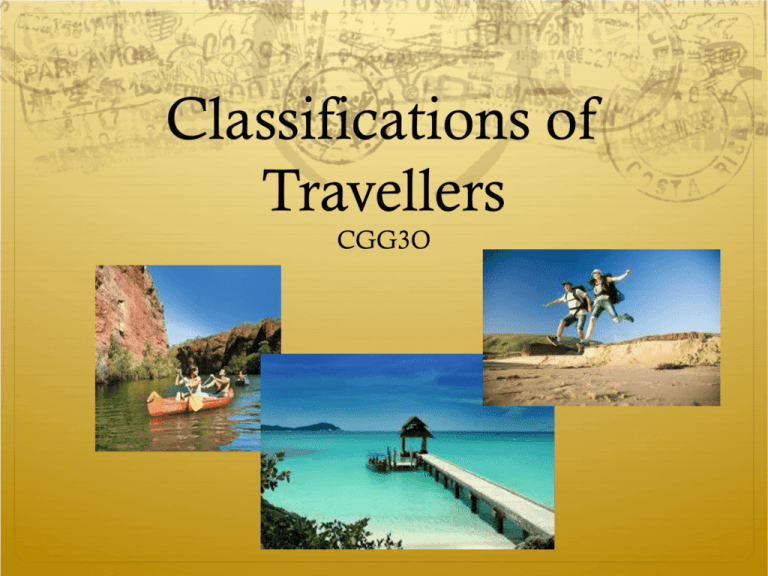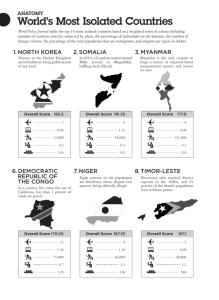Classifications of Tourism
advertisement

Classifications of Travellers CGG3O What Classifies as “Tourism”? You are known as a tourist if you are visiting a particular location for at least 24 hours (overnight) but less than a year. Otherwise you are simply known as a traveller. Migrants: Those who move their residences permanently or semi permanently (over a year) Same-day Visitors: Travellers who stay less than 24 hrs. Exercises: Using your textbook complete the exercise on Page 7, #8. Complete the following chart using the information on page 7. Tourism Revolution Year 2000 Everyday there were 1.8 million international travelers On average these people spent $1000/trip on accommodations, meals, entertainment, and shopping Worldwide tourism receipts = $700 billion Tourism revolution is a recent phenomenon (Began around 1900’s). Why? Time Money Need economic, social & technological changes to make tourism available to larger populations Labour laws such as paid vacations – middle class Today 80% of industrialized world’s pop. Received 3 weeks off Improvements in infrastructure – road & rail systems 1920’s Niagara Falls became a popular tourist destination 1930’s Canadians were traveling to Florida & South Carolina Mass tourism Movement of large #s of people to specialized tourist locations. Whole resort towns, theme parks, tourism business districts have been developed to attract mass tourist Example – Banff Late 1960s & 1970s people wanted to go on vacation without worrying about all the details. Creation of travel companies and package vacations Package Vacation – includes transportation, accommodations, meals, and entertainment. Working in Tourism 1 in 15 workers (123 million) worldwide were employed in tourism related jobs worldwide in 2000. – More today Tourism in one of the 3 leading categories of international trade. Direct employment – jobs that are generated by companies and government departments that deal directly with the traveling public. Examples: Theme parks, agencies, airports, hotels, museums, guides, restaurants. Indirect or Spin-off employment – Jobs that support the direct employment sector. Examples: Local farmers, suppliers, dry cleaning, printing companies Travel Barriers Cost Outside of your budget Time Other commitments limit time available. Health Weather Family Stage Lack of Interest Fear Poor health Extreme weather conditions (i.e. Winter in the Northern Hemisphere, and rainy seasons in the tropics) Parents with young children may not travel because of cost and inconvenience, or they may avoid certain types of travel, such as white-water rafting. People have other interests or are not interested in travel. Political conflicts or high crime rates in certain places may discourage people from travelling. Alternative Tourism Opposite of mass tourism Individualized activities Experience the local culture and environment first-hand Focuses on secluded areas and during the off season Ex. ________________________ Tourist Personalities Tourist locations or destinations are dependent on the personalities and desires of the tourist. Tourist personalities can be classified across a spectrum. The Spectrum Personality •Description Psychocentric • Not very adventurous • Like to stay close to home (little travel) • Familiar or recognizable locations (tourist areas) • Little difference in lifestyle and culture Allocentric • Adventure • Exotic destinations • Far away • Non-tourist areas • Different cultures Tourism personalities cont’d What type of tourist personalities would attend these locations? Canada’s Wonderland: Psychocentric Australia: Near Allocentric Florida: Near psychcentric Europe, Carribean, Hawaii: Mid-centric African safari, Antarctica: Allocentric







